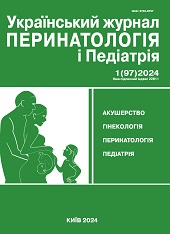Clinical features of the course of Hirschsprung’s disease in newborns and infants with consideration of the extent of colonic aganglionosis
DOI:
https://doi.org/10.15574/PP.2024.97.55Keywords:
Hirschsprung’s disease, children, enterocolitis, anemia, hypotrophy, associated malformationsAbstract
The clinical course of Hirschsprung’s disease (HD) in newborns and infants depends on the extent of сolonic aganglionosis, the age of patient, the presence of associated malformations and complications.
The aim - to study the peculiarities of the clinical course of HD in newborns and infants.
Materials and methods. An analysis of the clinical course of HD in 483 in newborns and infants. There were 100 (20.71%) patients with the rectal, 192 (39.75%) with rectosigmoid, 150 (31.05%) with subtotal, and 41 (8.49%) with total form of HD. 98 (20.29%) patients were found to have associated malformations.
Results. 64 (13.25%) patients with a rectal form, 72 (14.91%) - with rectosigmoid, 150 (31.05%) - with subtotal, and 41 (8.49%) with total form had an acute clinical course and subacute clinical course was observed in 36 (7.45%) patients with rectal and 120 (24.85%) with rectosigmoid forms of HD. 327 (67.70%) infants with HD were diagnosed with varying degrees of hypotrophy, 315 (65.22%) had HD-associated enterocolitis, 16 (3.31%) had toxic megacolon, and 241 (49.89%) patients had varying degrees of anemia.
Conclusions. In the presence of associated malformations in newborns and infants, in 8.07% of cases, clinical symptoms may prevail over the classic signs of HD. The severity of the course and late diagnosis are the main reasons for the appearance of severe complications of HD in newborns and infants - hypotrophy (67.70%), HD-associated enterocolitis (65.22%), toxic megacolon (3.31%) and anemia (49.89%).
The research was carried out in accordance with the principles of the Declaration of Helsinki. The research protocol was approved by the Local Ethics Committee of all institutions mentioned in the work. Informed consent of the children’s parents was obtained for the research.
No conflict of interests was declared by the authors.
References
Amiel J, Lyonnet S. (2001). Hirschsprung disease, associated syndromes, and genetics: a review. J Med Genet. 38(11): 729-739. https://doi.org/10.1136/jmg.38.11.729; PMid:11694544 PMCid:PMC1734759
Avansino JR, Levitt MA. (2017). Hirschsprung disease. In Fundamentals of pediatric surgery. 2, Mattei P. et al. (eds.). Springer International Publishing, Cham.: 513-524. https://doi.org/10.1007/978-3-319-27443-0_62
Byström C, Östlund S, Hoff N, Wester T, Granström AL. (2020). Evaluation of bowel function, urinary tract function, and quality of life after transanal endorectal pull-through surgery for Hirschsprung's Disease. Eur J Pediatr Surg. 31(1): 40-48. https://doi.org/10.1055/s-0040-1715612; PMid:32877942
Frykman PK, Short SS. (2012, Nov). Hirschsprung-Associated Enterocolitis: Prevention and Therapy. Semin Pediatr Surg. 21 (4): 328-335. https://doi.org/10.1053/j.sempedsurg.2012.07.007; PMid:22985838 PMCid:PMC3462485
Garg SR, Sathe PA, Taware AC, Surve KM. (2016). Fatal Toxic Megacolon in a Child of Hirschsprung Disease. J Clin Diagn Res. 10 (12): ED03-ED05. Published online 2016 Dec 1. https://doi.org/10.7860/JCDR/2016/21075.9083; PMid:28208866 PMCid:PMC5296439
Gershon EM, Rodriguez L, Arbizu RA. (2023). Hirschsprung's disease associated enterocolitis: A comprehensive review. World J Clin Pediatr. 12(3): 68-76. https://doi.org/10.5409/wjcp.v12.i3.68; PMid:37342453 PMCid:PMC10278080
Kapur RP, Smith C, Ambartsumyan L. (2020). Postoperative pullthrough obstruction in Hirschsprung disease: etiologies and diagnosis. Pediatr Dev Pathol. 23: 40-59. https://doi.org/10.1177/1093526619890735; PMid:31752599
Kawaguchi AL, Guner YS, Sømme S, Quesenberry AC, Arthur LG, Sola JE et al. (2021). Management and outcomes for long-segment Hirschsprung disease: A systematic review from the APSA Outcomes and Evidence Based Practice Committee. J Pediatr Surg. 56(9): 1513-1523. https://doi.org/10.1016/j.jpedsurg.2021.03.046; PMid:33993978 PMCid:PMC8552809
Khasanov R, Schaible T, Wessel LM, Haql Cl. (2016). The Surgical Treatment of Toxic Megacolon in Hirschsprung Disease Paediatr Emer Care. 32(11): 785-788. https://doi.org/10.1097/PEC.0000000000000444; PMid:26181500
Kyrklund K, Sloots CEJ, de Blaauw I, Bjørnland K, Rolle U, Cavalieri D et al. (2020). ERNICA guidelines for the management of rectosigmoid Hirschsprung's disease. Orphanet J Rare Dis. 15 (1): 164. https://doi.org/10.1186/s13023-020-01362-3; PMid:32586397 PMCid:PMC7318734
Lampus H. (2023). Overview of Hirschsprung Disease: A Narrative Literature Review. Scientific Journal of Pediatrics. 1(1): 14-16. https://doi.org/10.59345/sjped.v1i1.14
Neuvonen MI, Kyrklund K, Rintala RJ, Pakarinen MP. (2017). Bowel function and quality of life after trans anal endorectal pull-through for Hirschsprung disease: controlled outcomes up to adulthood. Ann Surg. 265 (03): 622-629. https://doi.org/10.1097/SLA.0000000000001695; PMid:28169931
Prytula V, Kurtash O. (2022). Long-term outcomes of mini-invasive methods of surgical treatment of Hirschprung's disease in children. Lekarsky obzor. 71 (3): 111-115.
Prytula VP, Kurtash OO, Hussaini SF, Rusak PS. (2023). Comparison of clinical results of Transanal Endorectal Pull-Through of the colon with and without laparoscopic assistance in children with Hirschsprung's disease. Paediatric Surgery (Ukraine). 2 (79): 71-77. URL: https://med-expert.com.ua/journals/wp-content/uploads/2023/08/13-1.pdf. https://doi.org/10.15574/PS.2023.79.71
Reategui CO, Spears CA, Allred GA. (2021). Adults Hirschsprung's disease, a call for awareness. A case report and review of the literature. Int J Surg Case Rep. 79: 496-502. https://doi.org/10.1016/j.ijscr.2021.01.090; PMid:33757270 PMCid:PMC7889450
Rennie JM. (2012). Textbook of Neonatology. Edition 5. Churchill Livingstone Elsevier: 12. ISBN 978-0-7020-3479-4.
Rybalchenko VF. (2012). Toxic megacolon, dolichomegacolon in children. Paediatric Surgery. Ukraine. 4: 5-13. http://nbuv.gov.ua/UJRN/Khdv_2012_4_3.
Tran VQ, Mahler T, Dassonville M, Truong DQ, Robert A, Goyens P, Steyaert H. (2018). Long-Term Outcomes and Quality of Life in Patients after Soave Pull-Through Operation for Hirschsprung's Disease: An Observational Retrospective Study. Eur. J. Pediatr. Surg. 28 (5): 445-454. https://doi.org/10.1055/s-0037-1604115; PMid:28738437
Downloads
Published
Issue
Section
License
Copyright (c) 2024 Ukrainian Journal of Perinatology and Pediatrics

This work is licensed under a Creative Commons Attribution-NonCommercial 4.0 International License.
The policy of the Journal “Ukrainian Journal of Perinatology and Pediatrics” is compatible with the vast majority of funders' of open access and self-archiving policies. The journal provides immediate open access route being convinced that everyone – not only scientists - can benefit from research results, and publishes articles exclusively under open access distribution, with a Creative Commons Attribution-Noncommercial 4.0 international license(СС BY-NC).
Authors transfer the copyright to the Journal “MODERN PEDIATRICS. UKRAINE” when the manuscript is accepted for publication. Authors declare that this manuscript has not been published nor is under simultaneous consideration for publication elsewhere. After publication, the articles become freely available on-line to the public.
Readers have the right to use, distribute, and reproduce articles in any medium, provided the articles and the journal are properly cited.
The use of published materials for commercial purposes is strongly prohibited.

